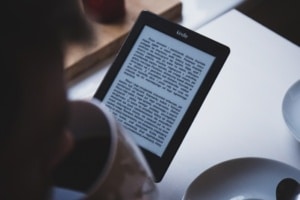The Evolution of the E-Book
Welcome back to Smith Publicity’s Industry Innovations Series! In this new 12-part blog series, the team at Smith Publicity will explore a variety of industry-related topics: from the evolution of self-publishing to the explosion of podcasts to social media and how it’s changed book marketing and much more. Each month, we will discuss how different innovations have evolved and the impact they’ve had on our work as book publicists and the industry as a whole. Let’s dive in…
Within a year of the start of Smith Publicity in 1997, e-books entered the market, and we were one of the first book publicity agencies to promote them. A couple that I distinctly remember is A Little Lower Than the Angels by Marty Gallanter and Gabriella’s Voice by Michael Vaughn – both excellent books, by the way. 
It was difficult pitching for media coverage of e-books at the time, primarily because some people didn’t know how to read them or have the technology or devices to read them, and they were a relatively foreign concept. Ironically, the e-book publisher I worked with had to print copies of the book to get attention for the e-book.
While the evolution of e-books goes all the way back to the 1930s, the process of becoming commercially viable began in the late 90s. I remember learning of the “Rocket Reader.” The technology of the Rocket directly led to subsequent e-readers such as the Amazon Kindle.
As impressive as the Rocket was, like most new technology, it had some issues. “The eBook is pleasant to read for a half-hour at most,” a PC Magazine review explained, “your eyes will start complaining if you use it for longer periods.”
As the technology improved over the ensuing years, some publishing experts predicted e-books would ultimately dominate the market, making print books almost obsolete. Why wouldn’t they? Instead of buying printed books and lugging them around, why not load your e-reader up with multiple books? Think of what e-readers can do today, how easy they make reading, and all of the additional functions they offer. Plus, they generally cost much less than printed books. Knowing the technology would improve quickly, it made sense, on the one hand, to believe e-books would become the preferred choice over time.
However, there were some inherent problems with the e-book domination prediction. Think about gift books, which account for a substantial percentage of book sales – up to 40%. People love giving books as gifts for holidays and birthdays, but people don’t give e-books as gifts, as it’s just not the same since you can’t wrap an e-book.
Additionally, nothing can replace the feel and even smell of a book. The tactile appeal of holding a book and turning pages is powerful.
There is also the issue of wanting others to see what you’re reading. You could look impressive on the train holding a copy of War and Peace. With an e-book, no one sees what you’re reading, so you can’t show off! But, this fact also helped e-books become popular…
You may remember a book called 50 Shades of Grey, in my opinion, the most significant phenomenon ever in the publishing industry, at one point accounting for 20% of all book sales. 50 Shades of Grey was the perfect book for e-reading. It enabled people to publicly read the book without anyone knowing they were reading a very erotic, controversial book. Women accounted for a huge percentage of readers of the book, up to 80% in the U.S, and could use their e-reader to read discreetly. It is safe to say that without e-books, 50 Shades of Grey might not have achieved the success it did.
So, ultimately, e-books obviously didn’t destroy the printed book, but e-book sales do account for roughly 20% of U.S. book sales. I predict their market share will remain consistent, perhaps growing to perhaps 30% of sales over time. Overall, it is safe to say they are here to stay.
Written by Dan Smith, Founder, and CEO
